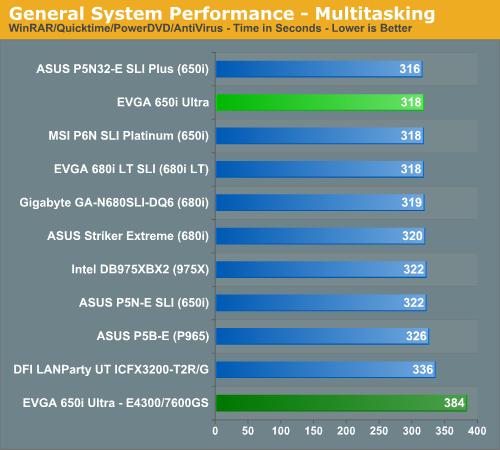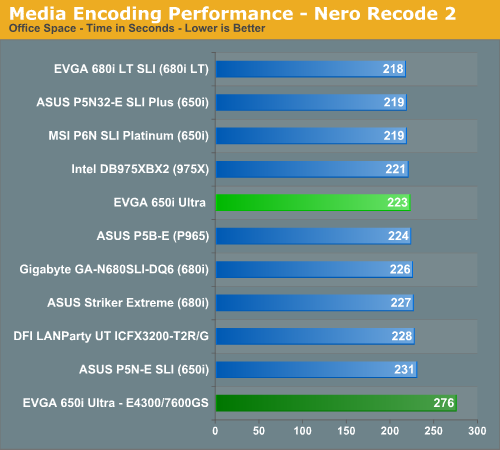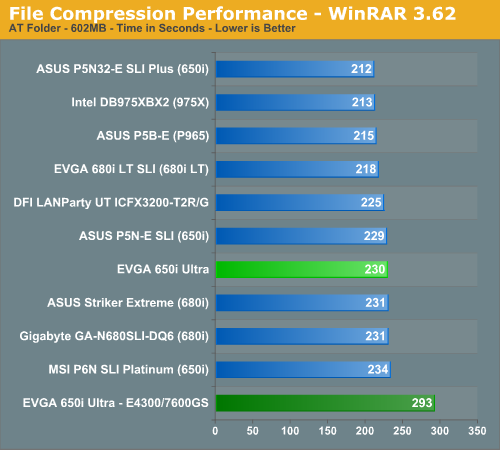EVGA nForce 650i Ultra: Performance on a Budget
by Gary Key on April 10, 2007 2:00 AM EST- Posted in
- Motherboards
Multitasking Performance
We devised a script that would compress our standard test folder consisting of 444 files, ten subfolders, and 602MB worth of data, convert a 137MB High Definition QuickTime movie clip to a 37MB MPEG-4 format, play back the first two chapters of Office Space with PowerDVD, and run our AVG anti-virus program in the background. We stop the script when the file compression and video conversion are complete. This is a very taxing script for the CPU, Memory, and Storage subsystem. We also found it to be a good indicator of system stability during our overclocking testing.

The performance difference basically mirrors our PCMark 2005 tests with the ASUS, MSI, and EVGA boards finishing at the top due to great disk performance, although the Intel boards consistently completed the QuickTime Conversion first. The differences in this test between the ASUS and EVGA boards were minimal with WinRAR showing the only measurable benefits due to tighter memory sub-timings on the ASUS Plus board.
Media Encoding Performance
Our first encoding test is quite easy - we take our original Office Space DVD and use AnyDVD Ripper to copy the full DVD to the hard drive without compression, thus providing an almost exact duplicate of the DVD. We then fire up Nero Recode 2, select our Office Space copy on the hard drive, and perform a shrink operation to allow the entire movie along with extras to fit on a single 4.5GB DVD disc. We leave all options on their defaults except we turn off the advanced analysis option. The scores reported include the full encoding process and are represented in seconds, with lower numbers indicating better performance.

We expected a stronger finish from the EVGA 650i Ultra board in this test based upon previous results. With CPU throughput and disk access times being the critical factors affecting test scores this board should have scored near or at the top. We ran this test with slightly tighter memory sub-timings and also tried 2T timings with 3-3-3-8 settings but the score remained constant at 223 seconds. In this particular test we feel like CPU throughput is slightly hindering the board's performance, although this is not true in every benchmark. We say this because the disk access time and transfer rate for the video files were the best in our secondary tests measuring disk throughput.
Audio Encoding Performance
While the media encoding prowess of the boards was superb in our initial media encoding testing, we wanted to see how they faired on the audio side. Our audio test suite consists of Exact Audio Copy v095.b4 and LAME 3.98a3. We utilize the INXS Greatest Hits CD that contains 16 tracks totaling 606MB of one time '80s hits. We set up EAC for variable bit rate encoding, burst mode for extraction, use external program for compression, and to start the external compressor upon extraction (EAC will read the next track while LAME is working on the previous track, thus removing a potential bottleneck with the optical drive). We also set the number of active threads to two to ensure both cores are active during testing. The results are presented in seconds for the encoding process, with lower numbers being better.
Our Plextor drive consistently took two minutes and nine seconds to read all sixteen tracks. This means our test systems are only utilizing one core during testing until the midway point of the extraction process where the drive speed begins exceeding the capability of the encoder and requires the use of a second thread.

Unlike the media encoding section we see the EVGA 650i Ultra scoring extremely well in a benchmark where CPU and Disk throughput are very important. Based on our previous results we would have to say that disk access and transfer speeds greatly assisted our EVGA board in obtaining the top score in this benchmark.
File Compression Performance
In order to save space on our hard drives and to provide another CPU crunching utility, we will be reporting our file compression results with the latest version of WinRAR that fully supports multi-treaded operations and should be of particular interest for those users with dual core or multi-processor systems. Our series of file compression tests utilizes WinRAR 3.62 to compress our test folder that contains 444 files, ten subfolders, and 602MB worth of data. All default settings are utilized in WinRAR along with our hard drive being defragmented before each test.

The performance of the EVGA 650i Ultra in this benchmark really disappointed us after the ASUS Plus results in our last article. We thought the code had been cracked on the NVIDIA boards and performance would be more competitive in the future with this benchmark. Our 650i board scored near the bottom of the pack but still bested several other boards with NVIDIA chipsets. We tried several combinations of memory modules and timings to no avail in this benchmark. As they say, "It is what it is." In this case that means it's slow.
We devised a script that would compress our standard test folder consisting of 444 files, ten subfolders, and 602MB worth of data, convert a 137MB High Definition QuickTime movie clip to a 37MB MPEG-4 format, play back the first two chapters of Office Space with PowerDVD, and run our AVG anti-virus program in the background. We stop the script when the file compression and video conversion are complete. This is a very taxing script for the CPU, Memory, and Storage subsystem. We also found it to be a good indicator of system stability during our overclocking testing.

The performance difference basically mirrors our PCMark 2005 tests with the ASUS, MSI, and EVGA boards finishing at the top due to great disk performance, although the Intel boards consistently completed the QuickTime Conversion first. The differences in this test between the ASUS and EVGA boards were minimal with WinRAR showing the only measurable benefits due to tighter memory sub-timings on the ASUS Plus board.
Media Encoding Performance
Our first encoding test is quite easy - we take our original Office Space DVD and use AnyDVD Ripper to copy the full DVD to the hard drive without compression, thus providing an almost exact duplicate of the DVD. We then fire up Nero Recode 2, select our Office Space copy on the hard drive, and perform a shrink operation to allow the entire movie along with extras to fit on a single 4.5GB DVD disc. We leave all options on their defaults except we turn off the advanced analysis option. The scores reported include the full encoding process and are represented in seconds, with lower numbers indicating better performance.

We expected a stronger finish from the EVGA 650i Ultra board in this test based upon previous results. With CPU throughput and disk access times being the critical factors affecting test scores this board should have scored near or at the top. We ran this test with slightly tighter memory sub-timings and also tried 2T timings with 3-3-3-8 settings but the score remained constant at 223 seconds. In this particular test we feel like CPU throughput is slightly hindering the board's performance, although this is not true in every benchmark. We say this because the disk access time and transfer rate for the video files were the best in our secondary tests measuring disk throughput.
Audio Encoding Performance
While the media encoding prowess of the boards was superb in our initial media encoding testing, we wanted to see how they faired on the audio side. Our audio test suite consists of Exact Audio Copy v095.b4 and LAME 3.98a3. We utilize the INXS Greatest Hits CD that contains 16 tracks totaling 606MB of one time '80s hits. We set up EAC for variable bit rate encoding, burst mode for extraction, use external program for compression, and to start the external compressor upon extraction (EAC will read the next track while LAME is working on the previous track, thus removing a potential bottleneck with the optical drive). We also set the number of active threads to two to ensure both cores are active during testing. The results are presented in seconds for the encoding process, with lower numbers being better.
Our Plextor drive consistently took two minutes and nine seconds to read all sixteen tracks. This means our test systems are only utilizing one core during testing until the midway point of the extraction process where the drive speed begins exceeding the capability of the encoder and requires the use of a second thread.

Unlike the media encoding section we see the EVGA 650i Ultra scoring extremely well in a benchmark where CPU and Disk throughput are very important. Based on our previous results we would have to say that disk access and transfer speeds greatly assisted our EVGA board in obtaining the top score in this benchmark.
File Compression Performance
In order to save space on our hard drives and to provide another CPU crunching utility, we will be reporting our file compression results with the latest version of WinRAR that fully supports multi-treaded operations and should be of particular interest for those users with dual core or multi-processor systems. Our series of file compression tests utilizes WinRAR 3.62 to compress our test folder that contains 444 files, ten subfolders, and 602MB worth of data. All default settings are utilized in WinRAR along with our hard drive being defragmented before each test.

The performance of the EVGA 650i Ultra in this benchmark really disappointed us after the ASUS Plus results in our last article. We thought the code had been cracked on the NVIDIA boards and performance would be more competitive in the future with this benchmark. Our 650i board scored near the bottom of the pack but still bested several other boards with NVIDIA chipsets. We tried several combinations of memory modules and timings to no avail in this benchmark. As they say, "It is what it is." In this case that means it's slow.










18 Comments
View All Comments
Zak - Tuesday, April 10, 2007 - link
Is there a SPDIF out bracket included? I'd find that a show stopper if it wasn't. Also, regarding the layout: with more and more video cards being quite large these days why they don't allow some extra space between the PCIx graphics slot and the next slot? This is a huge problem with mobos IMHO. Just because I want non-SLI, midrange motherboard doesn't mean I won't have a high end video card in it. Zak.saratoga - Tuesday, April 10, 2007 - link
I noticed the onboard sound benchmarks, but theres nothing about the onboard sound quality. Rightmark has a benchmark for this that take 2 minutes to run and spits out very useful information. Why not include those results like some other sites do?While knowing how it performs is great, knowing if the results are worth listening to is also important. I don't care if its the fastest onboard sound in the world, if its got poor SNR figures, I'm probably going to buy a PCI card :)
yacoub - Tuesday, April 10, 2007 - link
Added two items to your list of desired additions. If a 650i Ultra board came out with the above features, it'd be worth an additional 25% in price to me. (i.e. $125)
It's still practically amazing how well the C2D chips OC even on this board with its somewhat limited overclocking features. =)
Thanks again for a great review Gary.
yacoub - Tuesday, April 10, 2007 - link
Thanks for including the benchmarks with a real-world system. It's neat to see how incredibly different most of the test results are compared to your monster rig with XLC Flex RAM and an 8800GTX. ;)yacoub - Tuesday, April 10, 2007 - link
So don't buy this board if your DDR2 sticks want to run at 2.2v or 2.3v.
yacoub - Tuesday, April 10, 2007 - link
Ah yes, there you go:So time to wait and see if any other folks (Asus, Abit, MSi, etc) come out with a 650i board that offers better adjustment options in the BIOS.
Also would like to see a fully solid-capacitor design as well. Wouldn't mind paying $120-$125 for one of these 650i Ultras with those features added.
yacoub - Tuesday, April 10, 2007 - link
I'm really glad you posted that nice feature chart on page 2 because I didn't know that only 680i boards got the EPP compatibility. Boy it sure would suck to spend extra money on nice high-performance DDR2 RAM that advertises really nice timings when EPP is enabled, only to find out your nice new 650i SLI or Ultra board doesn't support EPP.nullpointerus - Tuesday, April 10, 2007 - link
I'll probably be getting one of these when I upgrade to C2Q late this year. From my browsing experiences, the current crop of Core-compatible boards are much too expensive or lack the new features I would like to gain by upgrading to the new platform. Kudos to EVGA for bringing a solid mid-range board to market!I'm glad to hear nTune (almost) works properly with this board. On my NF4 Ultra board, nTune crashes everytime I try to bring up the system status/overclocking stuff, and BTW the software is a pain to get working in Vista--something like six error messages come up when started without administrator permissions. Hopefully, the Vista issues will be resolved in a few months.